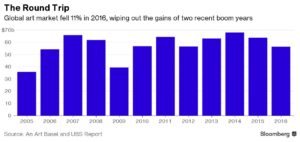Thanks to the exploding money growth over the last decade, courtesy of the Federal Reserve, the art market has become a lucrative industry. That is, until now.
As we reported earlier this month, the art market bubble is gradually bursting, and investors are losing as much as 74 percent on their investment (SEE: Art market bubble bursting – is the vintage car market next?). This is just the beginning, and other luxury markets are also crumbling, such as the vintage automobile market and the $100 million homes market.
To understand just how much the global art market is cratering, Bloomberg News released a chart, which highlighted the bubble burst. It found that the global art market plunged 11 percent in 2016.
Here is the chart:
In 2016, the total art market was worth $56.6 billion, down from $68.2 billion in the previous year. There is a great deal of uncertainty in 2017.
The business news network provided a list of some of the biggest losers:
Auction sales declined 26 percent to $22.1 billion, according to the report, released to coincide with the opening of Art Basel Hong Kong.
Sales of postwar and contemporary works at auction fell 18 percent to $5.6 billion; modern art was down 43 percent at $2.6 billion; the Impressionist category declined 31 percent to $1.3 billion.
The high end of the auction market — where prices for artworks exceed $1 million — fell 34 percent. Trophies priced at more than $10 million saw the biggest decline, at 53 percent.
Industry leaders Sotheby’s and Christie’s lost market share, together accounting for 38 percent of the auction sales, down from 42 percent in 2015.
Interestingly enough, some affluent investors may view their art purchases as safe-haven assets in a world of volatility.

Leave a Comment